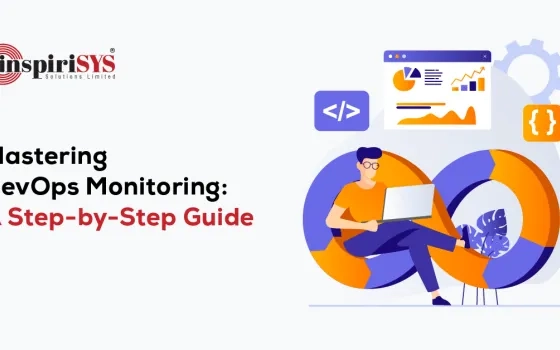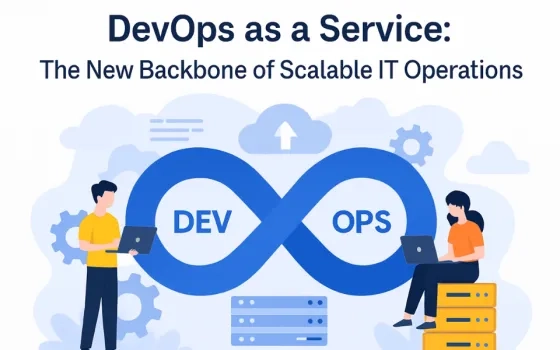In today’s ever-changing world, organizations are constantly striving to enhance efficiency, progress, and set themselves apart from their competitors.
One of the alternative ways to achieve this is through DevOps monitoring. The need for DevOps monitoring has increased due to modern code changes and a set of tools to support the entire software development lifecycle. Since the development and testing stages are happening constantly, the lifecycle is faster than ever.
By identifying issues at an early stage, DevOps monitoring best practices helps teams to prevent service failures.
As a result, continuous DevOps monitoring is required for full integration. Dive into the topic to know more about DevOps monitoring.
What is DevOps Monitoring?
DevOps monitoring refers to the continuous, automated process of identifying, tracking, analyzing, and reporting on specific components throughout the pipeline. Continuous Monitoring (CM) and Continuous Control Monitoring (CCM) are common terms in this context. Its goal is to aid software development teams in promptly identifying and addressing potential issues by monitoring application and system performance.
This is typically accomplished using a manual or automated DevOps monitoring solution or a collection of continuous monitoring tools to gather data on things like:
- Disk Space
- CPU Utilization
- Response Times
DevOps monitoring considers the entire process, that includes planning, development, operations, integration and testing. It entails a complete understanding of how the production environment’s infrastructure, services and applications are performing. Some of the critical components are historical replay, visualizations and real-time visibility which help DevOps monitoring teams can react quickly to any decline in the customer experience.
Exploring the Different Types of Monitoring in DevOps
The first step in implementing DevOps monitoring is to determine what needs to be monitored. Here are some of the most popular types of DevOps monitoring that you can make use of.
- Infrastructure Monitoring
- Application Performance Monitoring (APM)
- Network Monitoring
- Synthetic Monitoring
- Cost Monitoring
Let’s understand the different types of DevOps monitoring in detail.

Infrastructure Monitoring
Infrastructure monitoring is the process of tracking infrastructure in real time, which includes servers, data centres, and storage. Utilising specialised monitoring tools, the information can be collected and examined to monitor the entire IT infrastructure, including the monitoring of the OS, hardware, software and network.
Some of the common tools include Solarwinds, Prometheus and ManageEngine.
Application Performance Monitoring (APM)
The runtime metrics of applications can be gained by monitoring an application including security, log monitoring and overall app performance. Application performance monitoring is considered important as it allows for resolving the issue before it affects the overall system.
Application performance monitoring tools track metrics such as:
- API responses and transactions
- System responses
- Real-User Monitoring (RUM) and many more
A few examples include Splunk, DataDog and Uptrends.
Network Monitoring
Network monitoring involves actively tracking the performance of a network. This is done by utilizing specialized tools that analyze the performance of servers, switches, virtual machines, and firewalls. By monitoring the network, potential issues can be identified and addressed before they cause major problems such as downtime or system failures. Some renowned tools include Spiceworks, Wireshark and Cacti.
Synthetic Monitoring
Synthetic Monitoring relies on user behavioural patterns to stimulate fundamental end-user interactions with websites and applications.
The main goal is to assess a system component’s functionality, performance or speed to understand how a user would interact with an app or website. Additionally, it allows you to maintain peak performance and create a benchmark for the future.
New Relic, SpeedCurve, and Sematext are some of the common tools that are readily available on the market.
Cost Monitoring
Primarily, tracking the cost of operation is important as the DevOps pipeline involves significant money. To make a business profitable, price control is necessary. Continuous tracking of resource usage is necessary for cost monitoring. This can be accomplished by utilizing a range of cost-monitoring metrics, that help to determine the cost per unit precisely. Thus, the total cost can be determined with these metrics during several stages of DevOps.
Some of the popular cloud monitoring tools are ParkMyCloud, CloudZero, and Amazon Cloudwatch.
Click here to check out the Top 20 DevOps Monitoring Tools to Look out for in 2023.
The Benefits of DevOps Monitoring in Business
DevOps monitoring is essential for teams to improve the efficiency of the software development lifecycle. Being proactive, DevOps monitoring detects performance gaps and identifies bugs before they cause serious issues. Further, the place of automation is also highlighted, thereby improving the DevOps toolchain. Since it offers advanced features, it encourages DevOps teams to utilize tools for altering, deployment and many more.
Here are the common benefits of DevOps monitoring:

Automated Collaboration:
The fundamental principle of DevOps is to boost collaboration between development and operations teams. However, a lack of integration between tools can bring the coordination down. Therefore, leveraging automated collaboration provides a complete view of the development pipeline and notifies the development team about any bug issues, improvements and many more.
Improves Complete Visibility:
When codes undergo frequent changes, continuous integration and deployment increase the difficulty. Due to the incorporation of microservices and micro front-ends, different workloads are running in production with different requirements of scale, security and latency. Hence, it is crucial that DevOps teams identify and address customer experience on time.
Experimentation:
Continuous experimentation is essential to optimizing products to meet customer needs and is driven by optimized conversion and personalization. Since hundreds of trails are run it is difficult to address the root cause of the user experience. Hence, service-level objectives should be used by development teams.
Unlocking the Power of DevOps Monitoring Strategies
The DevOps monitoring strategy is important to implement the development process appropriately. Let’s check out the DevOps monitoring strategies:
Choose What to Monitor
The primary goal should be on what needs to be monitored and why. The aim should focus on the server’s vulnerabilities, health, and user activity.
Establish Fixed Development Goals
The fixed goals help to monitor the DevOps monitoring strategies. Further, it provides insights into team performance and workflow efficiency. One of the best ways to ensure the outcome is to record the average time taken to fix bugs and document them. To automate the process, tools can also be used.
Select the Right Monitoring Tool
The right continuous monitoring tool is much needed to meet the business goal. The best DevOps Monitoring tool depends on the type of systems or metrics you need to track, it's compatible with the organization and the overall objective. The basic requirement includes alerting, logging and reporting.
Use Cases of DevOps Monitoring
Certainly, there is no doubt that DevOps monitoring offers numerous benefits to any business. But the complete success rests on employing it effectively. Pointed below are the use cases of DevOps monitoring employed by businesses to reach the way to success.
Monitoring Git Workflows
Codebase conflicts are possible when several developers are occupied on the same project. These conflicts can be removed by Git which comprises rollbacks and commits. The Git workflow keeps track of these conflicts and sustains constant progress.
Distributed Tracing
Distributed tracing is essential for microservices applications to accelerate monitoring and debugging procedures. Knowing how the applications communicate with one another through APIs will help the DevOps teams detect the problems more quickly and fix them.
Code Instrumentation
Code instrumentation is the practice of adding code to monitor an application’s operation and performance. It is necessary to view contextual values and track stack calls. The efficiency of DevOps practices can be determined, and potential gaps can also be identified. Here, the detection of bugs and testing is an important factor to consider.
Continuous Integration/Deployment Logs
Monitoring the CI/CD pipeline is important for a healthy system. Generally, warnings or errors are given through CI logs. In addition, the overall health is monitored through CD logs on the development pipeline. It aids in troubleshooting the failed deployments and gives way to resolving the issues.
Linting the Code
The code linting tools are used to examine the style, syntax and potential errors. These tools are used to detect the bugs before they cause runtime errors. Further, it keeps the code clear and coherent.
Conclusion
As the complexity of software development is increasing, monitoring systems must keep up with DevOps deployments. Selecting the best monitoring solution that recognizes the numerous moving parts and how they interact can be a crucial choice. Also, it is suggested to employ expert service providers to make sure you take the right action at the right time.
Continuous Monitoring is crucial in DevOps because it enhances security, minimizes downtime, fixes performance issues and supports the development of business growth. Further, it brings collaboration between development and operation teams.
Frequently Asked Questions (FAQs)
1. What qualities make the DevOps monitoring platform ideal?
When selecting a DevOps monitoring solution, consider the features that will enable you to boost your investments. Further, complex applications require frequent updates. Thus, the advanced monitoring system is more important. These systems should support traditional as well as modern tools. The ideal platform should:
- Improve communications
- Provides access to real-time data
- Generate viewer-friendly report
2. Name some DevOps Monitoring tools for your application.
- Datadog
- Consul
- Monit
- Sensu
- Sematext
3. What are the main features of DevOps Monitoring tools?
- Logging events
- Triggering alerts when metrics exceed the limit
- Creating graphs of historical trend data
- Creating log databases
4. Why is Shift-Left testing important?
Shift-Left testing is important as it provides numerous advantages like improving the quality of a product, decreasing errors, and reducing test cycles at the beginning of the lifecycle. By implementing testing procedures in environments before production, DevOps teams can get a continuous view of performance. This helps in identifying the bugs at an earlier stage and resolving them.
5. What are some of the additional DevOps monitoring use cases?
- Increased security
- Improved collaboration
- Enhanced user experience
- Reduced system downtime
- Enhanced observability

















